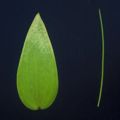Leaf or branch? The evolution of cladodes, an unusual leaf-like organ in Asparagus.

Plants show tremendous variation of form. In aerial parts of the plant, the diversity of form is seen in variations of stems, leaves, and branches. Elucidating the mechanisms underlying variations of each organ is indispensible for understanding the diversity of plant form. However, in contrast with the extensive work on diversification of leaf form, little is known concerning diversification of branch form.

Gross morphology of cladodes in the genus Asparagus. Cladodes in Asparagus asparagoides (left) and A. officinalis (right). © Hokuto Nakayama
In the genus Asparagus, foliage leaves are reduced to a vestigial scale-like form and no longer play a role as a photosynthetic organ. Instead, all species have cladodes, leaf-like organs which develop in the position of branches and are the main location of photosynthetic activity. The origin of cladodes has been debated due to their position and leaf-like form. Unveiling the process of their evolution may offer clues for understanding the diversification of the aerial part of plants in general.
A research group lead by Professor Hirokazu Tsukaya at the University of Tokyo’s Graduate School of Science performed anatomical and developmental analysis of cladodes and expression analysis of genes involved in leaf development. Based on their results, the research group has shown that cladodes in the genus Asparagus are modified lateral branches and that the leaf-like form of cladodes may be conferred by the ectopic expression of genes normally expressed in leaves to produce their flattened shape. Moreover, the group performed a similar experiment using another species, which has rod-like cladodes, and found that the alteration of the pattern of gene expression involved in flattening of cladodes may have led to the rod-like form during evolution of the genus Asparagus.
This research reveals the processes of diversification of form of lateral branches and demonstrates that the co-option and modification of preexisting genes are important for the acquisition and subsequent diversification of unique organs in plants.
Paper
Hokuto Nakayama, Takahiro Yamaguchi, and Hirokazu Tsukaya,
“Acquisition and Diversification of Cladodes: Leaf-Like Organs in the Genus Asparagus”,
The Plant Cell March 2012 tpc.111.092924 doi: 10.1105/tpc.111.092924
Article link






